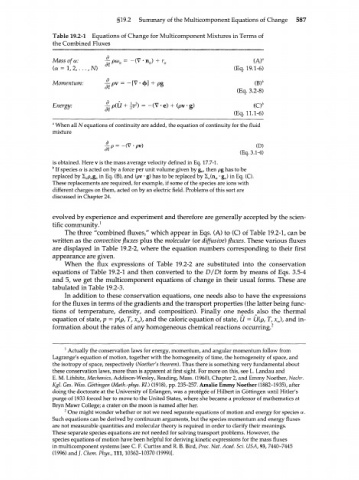Page 607 - Bird R.B. Transport phenomena
P. 607
§19.2 Summary of the Multicomponent Equations of Change 587
Table 19.2-1 Equations of Change for Multicomponent Mixtures in Terms of
the Combined Fluxes
Mass of a: j - pa> = - (V • n ) + r a (AY
a
a
l
(a = , 2 , . . . , N ) (Eq. 19.1-6)
Momentum: j- pv = -[V • ф] + pg (B) b
(Eq. 3.2-8)
2
p{
Energy: ft ^ + *v ) = -(V • e) + (pv • g) (C)"
(Eq. 11.1-6)
a
When all N equations of continuity are added, the equation of continuity for the fluid
mixture
j:P=-(V-pv) (D)
(Eq. 3.1-4)
is obtained. Here v is the mass average velocity defined in Eq. 17.7-1.
b
If species a is acted on by a force per unit volume given by g , then pg has to be
a
replaced by ^ p g in Eq. (B), and (pv • g) has to be replaced by X (n a • g ) in Eq. (C).
Q
u
a
a
a
These replacements are required, for example, if some of the species are ions with
different charges on them, acted on by an electric field. Problems of this sort are
discussed in Chapter 24.
evolved by experience and experiment and therefore are generally accepted by the scien-
tific community. 1
The three "combined fluxes/' which appear in Eqs. (A) to (C) of Table 19.2-1, can be
written as the convective fluxes plus the molecular (or diffusive) fluxes. These various fluxes
are displayed in Table 19.2-2, where the equation numbers corresponding to their first
appearance are given.
When the flux expressions of Table 19.2-2 are substituted into the conservation
equations of Table 19.2-1 and then converted to the D/Dt form by means of Eqs. 3.5-4
and 5, we get the multicomponent equations of change in their usual forms. These are
tabulated in Table 19.2-3.
In addition to these conservation equations, one needs also to have the expressions
for the fluxes in terms of the gradients and the transport properties (the latter being func-
tions of temperature, density, and composition). Finally one needs also the thermal
equation of state, p = p(p, T, x ), and the caloric equation of state, U = U(p, T, x ), and in-
a
a
formation about the rates of any homogeneous chemical reactions occurring. 2
1
Actually the conservation laws for energy, momentum, and angular momentum follow from
Lagrange's equation of motion, together with the homogeneity of time, the homogeneity of space, and
the isotropy of space, respectively (Noether's theorem). Thus there is something very fundamental about
these conservation laws, more than is apparent at first sight. For more on this, see L. Landau and
E. M. Lifshitz, Mechanics, Addison-Wesley, Reading, Mass. (1960), Chapter 2, and Emmy Noether, Nachr.
Kgl. Ges. Wiss. Gottingen (Math.-phys. Kl.) (1918), pp. 235-257. Amalie Emmy Noether (1882-1935), after
doing the doctorate at the University of Erlangen, was a protegee of Hilbert in Gottingen until Hitler's
purge of 1933 forced her to move to the United States, where she became a professor of mathematics at
Bryn Mawr College; a crater on the moon is named after her.
One might wonder whether or not we need separate equations of motion and energy for species a.
2
Such equations can be derived by continuum arguments, but the species momentum and energy fluxes
are not measurable quantities and molecular theory is required in order to clarify their meanings.
These separate species equations are not needed for solving transport problems. However, the
species equations of motion have been helpful for deriving kinetic expressions for the mass fluxes
in multicomponent systems [see C. F. Curtiss and R. B. Bird, Proc. Nat. Acad. Sci. USA, 93, 7440-7445
(1996) and /. Chem. Phys., Ill, 10362-10370 (1999)].

